Personal Finance
For those wondering “how long” the US equity run can continue – this is a very insightful piece of analysis from our in-house team. ~ Brent Woyat
As the great and the good in the world of economics and policy-making gather for the joint IMF and World Bank annual meetings in Washington this weekend, you may think they would be in a congratulatory mood given the synchronized positive growth in the global economy. Ahead of the meetings, the latest IMF economic projections point to a pick-up in global economic growth to 3.6% for this year and 3.7% for next, from the 3.2% growth in 2016. Moreover, the current global economic acceleration is broad based with all major regions and countries projected to grow this and next year. There are no signs of this economic expansion coming to an early end.
Even though the macro back-drop keeps improving, we can’t help but notice the polarization of views about equity markets. Notably, the focus on market valuation, sentiment and whether or not an equity market correction is overdue given the strong rally since 2009. We highlighted in previous Strategy Notes that equities are not cheap anymore, but they are not prohibitively expensive either. Indeed, investor sentiment indicators seem evenly balanced between bullish and bearish, and net mutual fund and ETF flows this year have favoured bonds over equity – hardly a signal of complacency. So what of the possibility of a market correction? Well that would seem likely at some point, we’ll probably see a few before the peak of this cycle, but the possibility of a major bear market does seem remote right now.
That is, the bigger picture here is that most bear markets in the US have coincided with a US recession – at least when looking back over the past fifty years. We don’t see the excesses in the economy that indicate a recession is likely in the short term. Indeed, most recessions in the US have occurred as a result of an over tightening of interest rate policy by the central bank. At the moment, the US Federal Reserve is approaching policy normalization in a cautious manner. The other two major causes of a US recession have been the oil price hikes in the 1970s and a bursting of a credit bubble in 2007. Presently, we do not foresee the price of oil rising to such a level or a severe credit event which might cause a recession. In addition, the strong US and global purchasing managers surveys point to a continuation of the positive economic momentum in the near term.
Given the economic and market uncertainties, a dilemma for some investors is either to participate in what they view as an over-extended stock market or wait for a more opportune time to invest. We would highlight that it is difficult to pinpoint the top of the market and crucially, that most bear markets take time to manifest themselves. This presents opportunities for investors. Provided the next recession is more than three months away, typical returns over the next six months would be positive, based on our analysis of US equity market returns over the past 50 years.
Figure 1 highlights the 7 bear markets in the S&P 500 Index over the past fifty-five years. We have defined a bear market as a fall of more than 20% or more in the Index based on weekly data. Most bear markets have coincided with a recession with the exceptions of 1966 and 1987.
Figure 2 highlights that most bear markets take time to correct. On a median basis, bear markets last 18 months with the shortest being 7 months (excluding the 1987 bear market) and the longest 21 months. Moreover, while the eventual percentage drop in a bear market is substantial, they are often accompanied by volatility in the initial period and thus take time to develop.
Figure 3 highlights the median losses in the initial periods following the start of the bear markets. The median losses were -4.7% and -7.7% after three and six months respectively. Moreover, if we consider the returns including the three and six months prior to the start of the bear market, then the losses tend to be minimal. The median return was -1.9% for the period between the 3 month prior and 3 month after the start of the bear market. On the six month window either sides, the median return was actually positive at 1.6% over the period.
So what does all this mean for the investment decision today? Essentially we believe that investors should be positioned for growth in a well-diversified portfolio. In the words of the Communards, “don’t leave me this way.” It is too early to capitulate, based on our assessment of markets and the economic cycle.
Brent Woyat, Canaccord Genuity


-
Inside the key channels or trend lines
-
At the Fibonacci levels
-
Just before the areas of strong resistance or support
Marc Faber is an international investor known for his uncanny predictions of the stock market and futures markets around the world.Dr. Doom also trades currencies and commodity futures like Gold and Oil.

 Within a twenty-four-hour span the Catalonian people voted 90 percent in favor of secession from Spain, despite the Spanish government’s effort to violently squelch the referendum, and a man in a Las Vegas hotel room opened fire on a concert, killing fifty-nine and wounding over 500. There’s no tangible connection between the two incidents, but they illustrate incipient forces still gathering steam that are transforming the world.
Within a twenty-four-hour span the Catalonian people voted 90 percent in favor of secession from Spain, despite the Spanish government’s effort to violently squelch the referendum, and a man in a Las Vegas hotel room opened fire on a concert, killing fifty-nine and wounding over 500. There’s no tangible connection between the two incidents, but they illustrate incipient forces still gathering steam that are transforming the world.
No government, military force, or intelligence unit has figured out how to stop those determined to kill large numbers of people if the killers are willing to forfeit their own lives. Nor will they. Individuals and small groups have the capability to amass and use large amounts of lethal weaponry, killing military and civilian targets in a guerrilla war, or victims on the deadly end of their random bullets or bombs.
Arguments that this can stopped by limiting access to weaponry are specious, serving only as cover for further expansion of government and curtailment of individual liberty. The trend towards cheaper, more widely distributed killing power stretches back to the invention of gun powder. Guns can now be manufactured at home with 3D printers. The cows left the barn long ago.
Standing in opposition to the forces of decentralized violence are the forces of centralized violence, governments….

Global Shortfall
UK Time Bomb
Swiss Cheese Retirement
Pay-As-You-Go Woes
Lisbon, Denver, Lugano, and Hong Kong
Today we’ll continue to size up the bull market in governmental promises. As we do so, keep an old trader’s slogan in mind: “That which cannot go on forever, won’t.” Or we could say it differently: An unsustainable trend must eventually stop.

Lately I have focused on the trend in US public pension funds, many of which are woefully underfunded and will never be able to pay workers the promised benefits, at least without dumping a huge and unwelcome bill on taxpayers. And since taxpayers are generally voters, it’s not at all clear they will pay that bill.
Readers outside the US might have felt smug and safe reading those stories. There go those Americans again, spending wildly beyond their means. You are correct that, generally speaking, we are not exactly the thriftiest people on Earth. However, if you live outside the US, your country may be more like ours than you think. Today we’ll look at some data that will show you what I mean. This week the spotlight will be on Europe.
First, let me suggest that you read my last letter, “Build Your Economic Storm Shelter Now,” if you missed it. It has some important background for today’s discussiion, as well as a special invitation to attend my Strategic Investment Conference next March 6–9 in San Diego. With so much change occurring so quickly now, next year’s conference is an event you shouldn’t miss.
Global Shortfall
I wrote a letter last June titled “Can You Afford to Reach 100?” Your answer may well be “Yes;” but, if so, you are one of the few. The World Economic Forum study I cited in that letter looked at six developed countries (the US, UK, Netherlands, Japan, Australia, and Canada) and two emerging markets (China and India) and found that by 2050 these countries will face a total savings shortfall of $400 trillion. That’s how much more is needed to ensure that future retirees will receive 70% of their working income. This staggering figure doesn’t even include most of Europe.
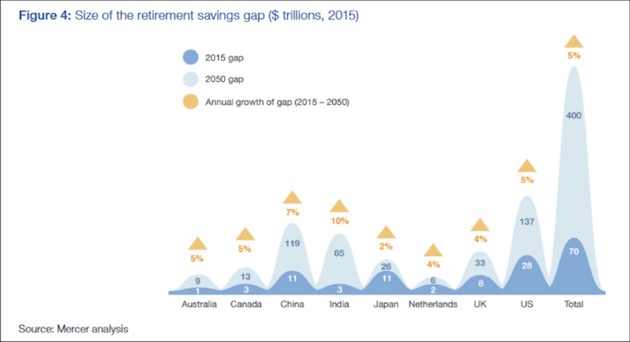
This problem exists in large part because of the projected enormous increase in median life expectancies. Reaching age 100 is already less remarkable than it used to be. That trend will continue. Better yet, I think we will also be healthier at advanced ages than people are now. Could 80 be the new 50? We’d better hope so, because the math is pretty bleak if we assume people will stop working at age 65–70 and then live another quarter-century or more.
That said, I think we’ll see a great deal of national variation in these trends. The $400 trillion gap is the shortfall in government, employer, and individual savings. The proportions among the three vary a great deal. Some countries have robust government-provided retirement plans; others depend more on employer and individual contributions. In the aggregate, though, the money just isn’t there. Nor will it magically appear just when it’s needed.
WEF reaches the same conclusion I did long ago: The idea that we’ll enjoy decades of leisure before our final decline simply can’t work. Our attempt to live out long and leisurely retirements is quickly reaching its limits. Most of us will work well past 65 whether we want to or not, and many of us will not have our promised retirement benefits to help us through our final decades.
What about the millions who are already retired or close to retirement? That’s a big problem, particularly for the US public-sector workers I wrote about in my last two letters. We should also note that we’re all public-sector workers in a way, since we must pay into Social Security and can only hope Washington gives us something back someday.
Let’s look at a few other countries that are not much better off.
UK Time Bomb
The WEF study shows that the United Kingdom presently has a $4 trillion retirement savings shortfall, which is projected to rise 4% a year and reach $33 trillion by 2050. This in a country whose total GDP is $3 trillion. That means the shortfall is already bigger than the entire economy, and even if inflation is modest, the situation is going to get worse. Further, these figures are based mostly on calculations made before the UK decided to leave the European Union. Brexit is a major economic realignment that could certainly change the retirement outlook. Whether it would change it for better or worse, we don’t yet know.
A 2015 OECD study (mentioned here) found that across the developed world, workers could, on average, expect governmental programs to replace 63% of their working-age incomes. Not so bad. But in the UK that figure is only 38%, the lowest in all OECD countries. This means UK workers must either build larger personal savings or severely tighten their belts when they retire. Working past retirement age is another choice, but it has broader economic effects – freezing younger workers out of the job market, for instance.
UK employer-based savings plans aren’t on particularly sound footing, either. According to the government’s Pension Protection Fund, some 72.2% of the country’s private-sector defined-benefit plans are in deficit, and the shortfalls total £257.9 billion. Government liabilities for pensions went from being well-funded in 2007 to having a shortfall 10 years later of £384 billion (~$500 billion). Of course, that figure is now out of date because, just a few months later, it’s now £408 billion – that’s how fast these unfunded liabilities are growing. Again, that’s a rather tidy sum for a $3 trillion economy to handle.
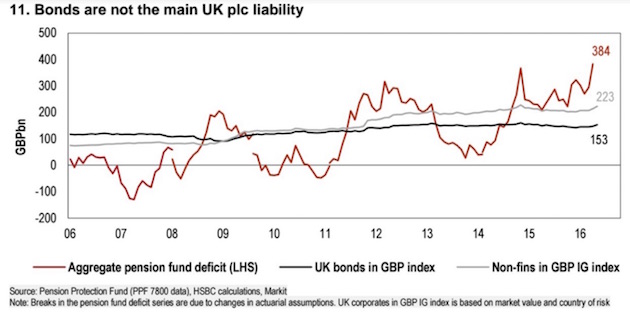
UK retirees have had a kind of safety valve: the ability to retire in EU countries with lower living costs. Depending how Brexit negotiations go, that option could disappear.
Turning next to the Green Isle, 80% of the Irish who have pensions don’t think they will have sufficient income in retirement, and 47% don’t even have pensions. I think you would find similar statistics throughout much of Europe.
A report this summer from the International Longevity Centre suggested that younger workers in the UK need to save 18% of their annual earnings in order to have an “adequate” retirement income – which it defines as less than today’s retirees enjoy. But no such thing will happen, so the UK is heading toward a retirement implosion that could be at least as damaging as the US’s.
Swiss Cheese Retirement
Americans often have romanticized views of Switzerland. They think it’s the land of fiscal discipline, among other things. To some extent that’s true, but Switzerland has its share of problems, too. The national pension plan there has been running deficits as the population grows older.
Earlier this month, Swiss voters rejected a pension reform plan that would have strengthened the system by raising women’s retirement age from 64 to 65 and raising taxes and required worker contributions. From what I can see, these were fairly minor changes, but the plan still went down in flames as 52.7% of voters said no.
Voters around the globe generally want to have their cake and eat it, too. We demand generous benefits but don’t like the price tags that come with them. The Swiss, despite their fiscally prudent reputation, appear to be not so different from the rest of us. Consider this from the Financial Times:
Alain Berset, interior minister, said the No vote was “not easy to interpret” but was “not so far from a majority” and work would begin soon on revised reform proposals.
Bern had sought to spread the burden of changes to the pension system, said Daniel Kalt, chief economist for UBS in Switzerland. “But it’s difficult to find a compromise to which everyone can say Yes.” The pressure for reform was “not yet high enough,” he argued. “Awareness that something has to be done will now increase.”
That description captures the attitude of the entire developed world. Compromise is always difficult. Both politicians and voters ignore the long-term problems they know are coming and think no further ahead than the next election. The remark that “Awareness that something has to be done will now increase” may be true, but there’s a big gap between awareness and motivation – in Switzerland and everywhere else.
Switzerland and the UK have mandatory retirement pre-funding with private management and modest public safety nets, as do Denmark, the Netherlands, Sweden, Poland, and Hungary. Not that all of these countries don’t have problems, but even with their problems, these European nations are far better off than some others.
(Sidebar: low or negative rates in those countries make it almost impossible for their private pension funds to come anywhere close to meeting their mandates. And many of the funds are by law are required to invest in government bonds, which pay either negligible or negative returns.)
Pay-As-You-Go Woes
The European nations noted above have nowhere near the crisis potential that the next group does: France, Belgium, Germany, Austria, and Spain are all pay-as-you-go countries (PAYG). That means they have nothing saved in the public coffers for future pension obligations, and the money has to come out of the general budget each year. The crisis for these countries is quite predictable, because the number of retirees is growing even as the number of workers paying into the national coffers is falling. There is a sad shortfall of babies being born in these countries, making the demographic reality even more difficult. Let’s look at some details.
Spain was hit hard in the financial crisis but has bounced back more vigorously than some of its Mediterranean peers did, such as Greece. That’s also true of its national pension plan, which actually had a surplus until recently. Unfortunately, the government chose to “borrow” some of that surplus for other purposes, and it will soon turn into a sizable deficit.
Just as in the US, Spain’s program is called Social Security, but in fact it is neither social nor secure. Both the US and Spanish governments have raided supposedly sacrosanct retirement schemes, and both allow their governments to use those savings for whatever the political winds favor.
The Spanish reserve fund at one time had €66 billion and is now estimated to be completely depleted by the end of this year or early in 2018. The cause? There are 1.1 million more pensioners than there were just 10 years ago. And as the Baby Boom generation retires, there will be even more pensioners and fewer workers to support them. A 25% unemployment rate among younger workers doesn’t help contributions to the system, either.
A similar dynamic may actually work for the US, because we control our own currency and can debase it as necessary to keep the government afloat. Social Security checks will always clear, but they may not buy as much. Spain’s version of Social Security doesn’t have that advantage as long as the country stays tied to the euro. That’s one reason we must recognize the potential for the Eurozone to eventually spin apart. (More on that below.)
On the whole, public pension plans in the pay-as-you-go countries would now replace about 60% of retirees’ salaries. Further, several of these countries let people retire at less than 60 years old. In most countries, fewer than 25% of workers contribute to pension plans. That rate would have to double in the next 30 years to make programs sustainable. Sell that to younger workers.
The Wall Street Journal recently did a rather bleak report on public pension funds in Europe. Quoting:
Europe’s population of pensioners, already the largest in the world, continues to grow. Looking at Europeans 65 or older who aren’t working, there are 42 for every 100 workers, and this will rise to 65 per 100 by 2060, the European Union’s data agency says. By comparison, the U.S. has 24 nonworking people 65 or over per 100 workers, says the Bureau of Labor Statistics, which doesn’t have a projection for 2060. (WSJ)
While the WSJ story focuses on Poland and the difficulties facing retirees there, the graphs and data in the story make clear the increasingly tenuous situation across much of Europe. And unlike most European financial problems, this isn’t a north-south issue. Austria and Slovenia face the most difficult demographic challenges, right along with Greece. Greece, like Poland, has seen a lot of its young people leave for other parts of the world. This next chart compares the share of Europe’s population that 65 years and older to the rest of the regions of the world and then to the share of population of workers between 20 and 64. These are ugly numbers.
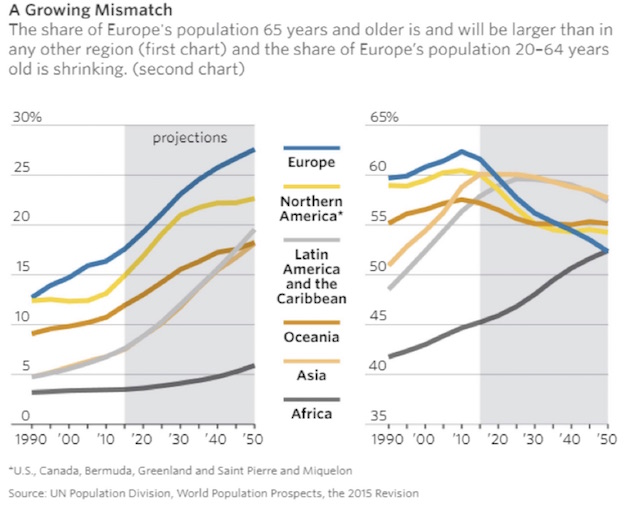
Source: WSJ
The WSJ continues:
Across Europe, the birthrate has fallen 40% since the 1960s to around 1.5 children per woman, according to the United Nations. In that time, life expectancies have risen to roughly 80 from 69.
In Poland birthrates are even lower, and here the demographic disconnect is compounded by emigration. Taking advantage of the EU’s freedom of movement, many Polish youth of working age flock to the West, especially London, in search of higher pay. A paper published by the country’s central bank forecasts that by 2030, a quarter of Polish women and a fifth of Polish men will be 70 or older.
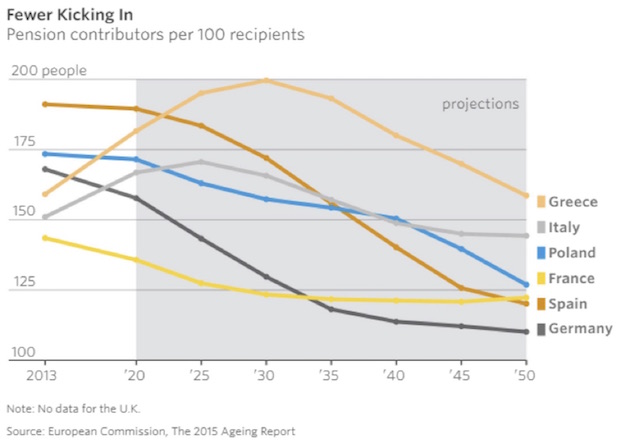
Source: WSJ
Next week we will look at the unfunded liabilities of the US government. It will not surprise anyone to learn that the situation is ugly, and there is no way – zero chance, zippo – that the US government will be able to fund those liabilities without massive debt and monetization.
Now, what I am telling you is that every bit of analysis about the pay-as-you-go countries in Europe suggests that they are in a far worse position than the United States is. Plus, the economies of those countries are more or less stagnant, and they are already taxing their citizens at close to 50% of GDP.
The chart below shows the percentage of GDP needed to cover government pension payments in 2015 and 2050. But consider that the percentage of tax revenues required will be much higher. For instance, in Belgium the percentage of GDP going to pensions will be 18% in about 30 years, but that’s 40–50% of total tax revenues. That hunk doesn’t leave much for other budgetary items. Greece, Italy, Spain? Not far behind.
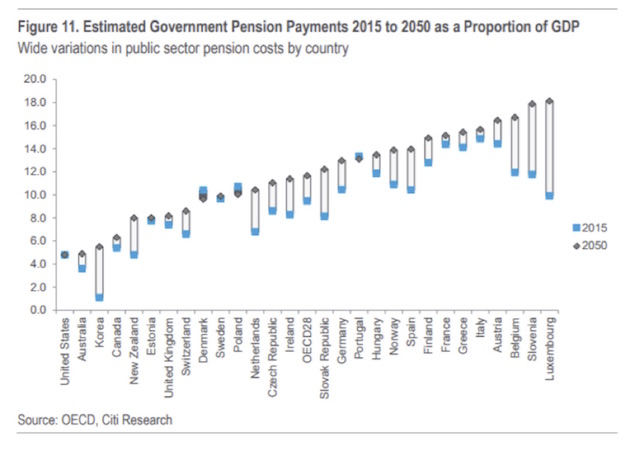
And there is other research that makes the above numbers seem optimistic by comparison. The problem that the European economies have is that for the most part they are already massively in debt and have high tax rates. And they can’t print their own currencies.
Many of Europe’s private pension companies and corporations are also in seriously deep kimchee. Low and negative interest rates have devastated the ability of pension funds to grow their assets. Combined with public pension liabilities, the total cost of meeting the income and healthcare needs of retirees is going to increase dramatically all across Europe.
Macron, the new French president, really is trying to shake up the old order, to his credit; and this week he came out and began to lay the foundation for the mutualization of all European debt, which I assume would end up on the balance sheet of the ECB. However, that plan still doesn’t deal with the unfunded liabilities. Do countries just run up more debt? It seems like the plan is to kick the can down the road just a little further, something Europe is becoming really good at.
In this next chart, note the line running through each of the countries, showing their debt as a percentage of GDP. Italy’s is already over 150%. And this is a chart based mostly on 2006 and earlier data. A newer chart would be much uglier.
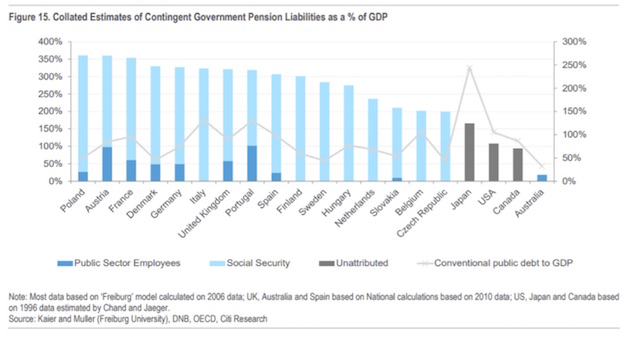
I could go on reviewing the retirement problems in other countries, but I hope you begin to see the big picture. This crisis isn’t purely a result of faulty politics – though that’s a big contributor – it’s a problem that is far bigger than even the most disciplined, future-focused governments and businesses can easily handle.
Look what we’re trying to do. We think people can spend 35–40 years working and saving, then stop working and go on for another 20–30–40 years at the same comfort level – but with a growing percentage of retirees and a shrinking number of workers paying into the system. I’m sorry, but that’s magical thinking. And it’s not what the original retirement schemes envisioned at all. Their goal was to provide for a relatively small number of elderly people who were unable to work. Life expectancies were such that most workers would not reach that point, or would at least live just a few years beyond retirement.
As I have pointed out in past letters, when Franklin Roosevelt created Social Security for people over 65 years old, US life expectancy was about 56 years. If the retirement age had kept up with the increase in life expectancy, the retirement age in the US would now be 82. Try and sell that to voters.
Worse, generations of politicians have convinced the public that not only is a magical outcome possible, it is guaranteed. Many politicians actually believe it themselves. They aren’t lying so much as just ignoring reality. They’ve made promises they aren’t able to keep and are letting others arrange their lives based on the assumption that the impossible will happen. It won’t.
How do we get out of this jam? We’re all going to make big adjustments. If the longevity breakthroughs I expect happen soon (as in the next 10–15 years), we may be able to adjust with minimal pain. We’ll work longer years, and retirement will be shorter, but it will be better because we’ll be healthier.
That’s the best-case outcome, and I think we have a fair chance of seeing it, but not without a lot of social and political travail. How we get through that process may be the most important question we face.
I haven’t even thrown in the complications that are going to arise because of changes in the nature of employment and the future of work that will be caused by technological change in the next 10–20 years. That will mean even fewer workers for each retiree. Facebook’s Zuckerberg talks about a basic minimum income. I think that is the wrong thing to do. It is the nature of human beings to need to do things that contribute meaningfully to the lives of their family and society. But the reality is that increasing numbers of people are already having trouble finding that sort of work.
Maybe we should think about basic minimum employment. FDR put a generation of people to work building public projects that helped get us through the Great Depression. Our world is going to change in ways that we don’t yet understand and that we are not prepared for, psychologically, socially, politically, or economically.
In the US and much of Europe we have developed social echo chambers in which we talk just to ourselves and those who are like-minded, ignoring or demonizing the other side. We have lost the ability to disagree rationally and productively. When the children’s books written by Dr. Seuss are considered by some to have been written by a white racist and are therefore deemed unacceptable to be in a public library, you know the quality of civil discourse has spiraled downward.
I do not like that, Sam I am.
Lisbon, Denver, Lugano, and Hong Kong
In a few hours, Shane and I will leave for the airport to catch a late-night flight to London and then on to Lisbon. My hosts, the event coordinators of the large food retailing group of Jerónimo Martins, have been particularly gracious with their arrangements and in giving us plenty of time to explore Lisbon. And the rest of the speaking lineup is quite impressive, so I imagine that I will be attending a lot of the conference. They are focused on how the world is changing, which is right up my alley.
Then we are back to Dallas on October 4 – my 68th (!) birthday – and I speak the next day at the Dallas Money Show. I am told that my 20-minute talk at 9:15 AM Central Time will be available on live stream. Go here and then click on the “LIVE STREAM” tab. I will be in Denver on November 6 and 7, speaking for the CFA Society and holding meetings. After a lot of small back-and-forth flights in November, I’ll end up in Lugano, Switzerland, right before Thanksgiving. Then there will be a (currently) lightly scheduled December, followed by an early trip to Hong Kong in January. It looks like Lacy Hunt and his wife, JK, will join Shane and me there. Lacy and I will come back home exhausted from trying to keep up with our indefatigable better halves.
I am really looking forward to both Lisbon and Hong Kong, and I have never been to Lugano. Some of the back-and-forth trips do wear me out, but I enjoy it when I get to play tourist with Shane. I am sure I will have to go on an even more serious diet when I get back from Lisbon, because everybody tells me the food is fabulous.
It’s time to hit the send button and get ready to run to the airport. You have a great week. I see a little port sampling in my near future. Just for appearances…
Your ready to explore Lisbon and Portugal analyst,

John Mauldin
subscribers@MauldinEconomics.com
Copyright 2017 John Mauldin. All Rights Reserved.


Here’s the least original statement of 2017: There are a lot of different ETFs. There are:
- Equity ETFs
- International ETFs
- Fixed income ETFs
- Currency ETFs
- Commodity ETFs
- Volatility ETFs
There are a few others I forgot, plus leveraged and inverse versions of most of these.
As you know, macro investing is where you take a top-down view of economic trends. You then take long or short positions in: equities, international equities, fixed income, currencies, commodities, volatility… with or without leverage.
WAIT A MINUTE.
ETFs have made it possible for everyday investors to invest like George Soros.
Except most everyday investors inevitably do a much worse job than George Soros!
Still, it is lots of fun. It is just probably not in the best interests of your retirement savings.
Just Because You Can, Doesn’t Mean You Should
ETFs give people the ability to do lots of different things. ETF innovators have managed to securitize just about anything.
I think we reached the last frontier in August when a LIBOR ETF was announced (it is leveraged, naturally). So you can trade LIBOR, you can trade a basket of junior silver miners, you can trade double inverse volatility, you can trade the shape of the yield curve, and you can trade Indonesia.
But I’ll bet you that the people who are investing in Indonesia have not done a lot of work on Indonesia. And I’ll bet you there are people speculating on the yield curve who have not done a lot of work on the yield curve.
Moral of the story: Just because you can do these things, doesn’t mean you should.
One thing a lot of investors don’t realize is that professional investors put an awful amount of time and effort into research.
I do a fair amount of research in the course of writing newsletters. And sometimes, I will meet with a portfolio manager who is working on the same trade.
That portfolio manager will have had a team of analysts working on it for months. So when he ends up buying that Indonesia ETF, he has done all the work, and he is pretty freakin’ sure.
Many investors haven’t done the work. They don’t have the time (they work day jobs) and they don’t have the scale (they don’t have a team of analysts working with them, with access to all the market data in the world).
Nobody likes to think of themselves as the patsy at the poker table. But you can’t compete with the pros.
Intermission
There’s a reason I opened this 10th Man with “the least original statement of 2017.” And that’s because ETFs are breaking all kinds of records this year: record numbers of ETFs, record inflows, record assets under management, record low fees. We live in The Age of the ETF.
It’s making me pretty curious about the “state of The 10th Man nation” when it comes to ETFs. What are you guys investing in? Why? How?
Normally I’d say “answers on a postcard,” but I’d appreciate it if you could take a few minutes to answer some questions on ETFs through this link:
There are ten questions, but seven are multiple choice, so it really won’t take you long.
Oh, and there’s a free copy of my latest report in it for you. It’s called Investing in the Age of the Everything Bubble and I can promise it’s a great (and useful) read.
Despite What I’ve Said, ETFs Are Your Friend
I am no financial Luddite. I think the ETF is one of the top five financial innovations of the last 100 years! Giving people access to stuff they never had access to before is a great development.
Thirty years ago, you couldn’t buy Indonesia at all. OK—maybe there was a closed-end fund, but that has its own issues. Aside from that, the only way to buy Indonesia was to be Mr. Big Time Portfolio Manager and access foreign markets through a big broker like Goldman Sachs.
So I would never be so paternalistic as to suggest that people should be prevented from trading this stuff for their own good. No. What I am saying is:
- Macro trading is a lot of work.
- You probably don’t have time to do the work.
- So you should be realistic about your expectations.
If you accept that and still really want to be a dedicated ETF investor (survey is this way), then here’s what you need to do.
Determine your asset allocation, and pick some broad-based, low cost ETFs, keeping concentration and correlation in mind. Try to avoid making radical changes to the portfolio unless absolutely necessary. And think long-term: 5-10 years, not 1-2 years.
Sound simple? If it does, it kind of shouldn’t.
One final personal note—it is possible that I will be affected by the very powerful Hurricane Irma (I live in South Carolina). If I am forced to evacuate, publication of The 10th Man may be interrupted. I’ll keep you posted.

Jared Dillian















